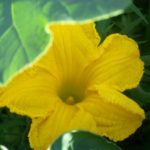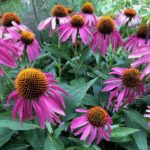Full Moon Greetings – June 3, 2023

Gifts of Comfrey
Comfrey (Symphytum officinale) has just begun to bloom in my garden. But the delicate bluish-purple flowers are easy to miss. Tiny bell shapes hang in clusters under the leaves. You have to look closely to admire them because they are dwarfed by the rest of the plant.

The comfrey plant itself is impressive, standing sometimes 3 feet or more. Large arrow shaped leaves give the plant a shrub like character. While comfrey flowers are not the showiest, it is well worth inviting this plant into your green space. It can provide gifts to the rest of your garden and healing routines, as well as add to your mindfulness practice.
Garden Gifts
Bees and other pollinators love comfrey. That is reason alone to include it in the garden. But one of the best reasons is its ability to add nutrients to your soil. Comfrey has a deep tap root that brings up minerals from the sub-soil. When you harvest the leaves and incorporate them into compost or chop them for mulch you are adding to soil nutrients. The plant can be harvested multiple times throughout the season. One plant provides a massive amount of leaves.
 Additionally, you can use the leaves to make a comfrey fertilizer by chopping the leaves and soaking them in water for a month. Use a five-gallon bucket, fill it with chopped up leaves, and cover with water. Be sure to cover the bucket with a lid. After one month, remove the leaves (which can then be composted) and use the liquid to fertilize plants. But be aware – this makes quite a stinky liquid. I only tried it once and I find it easier to simply harvest and chop the leaves and then add them to the existing mulch around plants.
Additionally, you can use the leaves to make a comfrey fertilizer by chopping the leaves and soaking them in water for a month. Use a five-gallon bucket, fill it with chopped up leaves, and cover with water. Be sure to cover the bucket with a lid. After one month, remove the leaves (which can then be composted) and use the liquid to fertilize plants. But be aware – this makes quite a stinky liquid. I only tried it once and I find it easier to simply harvest and chop the leaves and then add them to the existing mulch around plants.
If you’d like to establish comfrey in your garden, find a friend who can give you a piece of the root from their garden. It grows easily from a tiny root cutting. (Keep this in mind if you try to move comfrey. A small piece of root left behind will create a whole new plant.) Comfrey prefers some shade, making it easy to tuck away in an area you won’t be using for your sun loving plants. One stand of comfrey will supply you with generous and multiple harvests of leaves to add to your compost and mulch.
Healing Gifts
Comfrey is native to Europe and parts of Asia and has been part of herbal preparations for over two thousand years. Some of its many names include bruisewort, knitback, and knitbone, indicating an association with mending bones and healing bruises. In the past it was used both internally and externally, but it is no longer considered safe for internal use or on open wounds.
The Food & Drug Administration in the U.S. along with other regulator organizations have warned again taking comfrey internally. There is a risk of liver damage and death. (If you’d like to read more about the research they based their decisions on, check out this article at Science Direct)
article at Science Direct)
Comfrey is still considered safe to use topically for sprains, strains, and muscle soreness (just not on open cuts or wounds). I make a simple salve from the leaves every summer and it is great for achy muscles after spending a day in the garden.
Gifts of Mindfulness
One of comfrey’s many gifts is teaching us to pay attention to the smaller details and blessings in our lives. Comfrey flowers are small but beautiful. They remind us to cultivate attentiveness to the small wonders all around us.

Another reminder from this plant is the idea that it is okay to change our minds about things – whether those things are plants, people, or situations. As noted above, for many centuries this plant was recommended for internal use. We now have new data that suggests that is not healthy or wise. Sometimes it is hard to adjust our thinking about a trusted plant or concept, but taking in new information is a chance for us to be present with this moment in time and shift our actions accordingly.
Human nature seems to resist change. We see evidence of this everywhere as people struggle with new and different ideas. But just because things have always been done in a certain way doesn’t make them correct or true for this moment. Mindfulness practice directs us to take in new information with an open mind and open heart. That doesn’t mean we automatically accept any new idea as true, but it does mean we don’t reject it before thoughtful consideration.
So consider inviting comfrey into your garden and enjoy all of its many gifts, including the reminder to be present as life shifts and changes and new information is revealed to us. It is more than okay to let go of worn out concepts – especially if the new ones are healthier and more life affirming for everyone.
Lunar Blog Post Series

This post is part of my lunar blog series. Each full moon I write about one plant, many of them are plants featured in my book, Growing Mindful. Each new moon I write about a topic related to gardens, mindfulness, and spirituality. For more details and a list of past lunar blog posts, click here.



